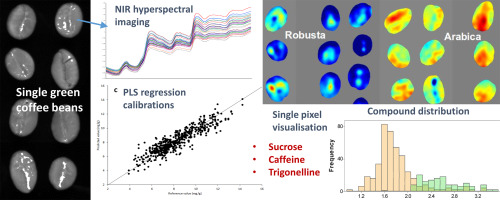Food Research International ( IF 7.0 ) Pub Date : 2017-12-14 , DOI: 10.1016/j.foodres.2017.12.031 Nicola Caporaso 1 , Martin B Whitworth 2 , Stephen Grebby 3 , Ian D Fisk 4

|
Hyperspectral imaging (HSI) is a novel technology for the food sector that enables rapid non-contact analysis of food materials. HSI was applied for the first time to whole green coffee beans, at a single seed level, for quantitative prediction of sucrose, caffeine and trigonelline content. In addition, the intra-bean distribution of coffee constituents was analysed in Arabica and Robusta coffees on a large sample set from 12 countries, using a total of 260 samples. Individual green coffee beans were scanned by reflectance HSI (980–2500 nm) and then the concentration of sucrose, caffeine and trigonelline analysed with a reference method (HPLC-MS). Quantitative prediction models were subsequently built using Partial Least Squares (PLS) regression. Large variations in sucrose, caffeine and trigonelline were found between different species and origin, but also within beans from the same batch. It was shown that estimation of sucrose content is possible for screening purposes (R2 = 0.65; prediction error of ~ 0.7% w/w coffee, with observed range of ~ 6.5%), while the performance of the PLS model was better for caffeine and trigonelline prediction (R2 = 0.85 and R2 = 0.82, respectively; prediction errors of 0.2 and 0.1%, on a range of 2.3 and 1.1% w/w coffee, respectively). The prediction error is acceptable mainly for laboratory applications, with the potential application to breeding programmes and for screening purposes for the food industry. The spatial distribution of coffee constituents was also successfully visualised for single beans and this enabled mapping of the analytes across the bean structure at single pixel level.
中文翻译:

通过高光谱成像对单颗生咖啡豆中的蔗糖、咖啡因和葫芦巴碱进行无损分析
高光谱成像 (HSI) 是食品领域的一项新技术,可对食品材料进行快速非接触式分析。 HSI 首次在单粒种子水平上应用于全生咖啡豆,定量预测蔗糖、咖啡因和葫芦巴碱含量。此外,还对来自 12 个国家的大样本集(总共 260 个样本)分析了阿拉比卡和罗布斯塔咖啡中咖啡成分的豆内分布。通过反射 HSI (980–2500 nm) 扫描单个生咖啡豆,然后使用参考方法 (HPLC-MS) 分析蔗糖、咖啡因和葫芦巴碱的浓度。随后使用偏最小二乘(PLS)回归建立了定量预测模型。不同品种和产地之间以及同一批次的咖啡豆中,蔗糖、咖啡因和葫芦巴碱的含量存在很大差异。结果表明,可以出于筛选目的估计蔗糖含量(R 2 = 0.65;预测误差约为 0.7% w/w 咖啡,观察范围约为 6.5%),而 PLS 模型对于咖啡因的性能更好和葫芦巴碱预测(分别为 R 2 = 0.85 和 R 2 = 0.82;对于 2.3% 和 1.1% w/w 咖啡,预测误差分别为 0.2% 和 0.1%)。预测误差主要对于实验室应用来说是可以接受的,也有可能应用于育种计划和食品工业的筛选目的。咖啡成分的空间分布也成功地可视化为单个咖啡豆,这使得分析物在单个像素水平上在咖啡豆结构上进行映射成为可能。











































 京公网安备 11010802027423号
京公网安备 11010802027423号